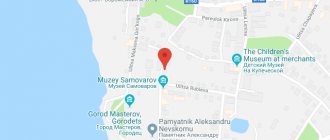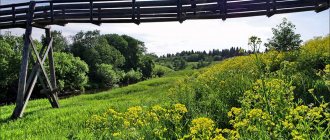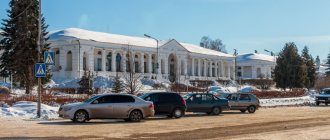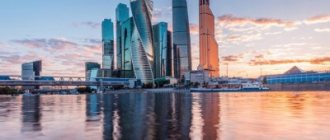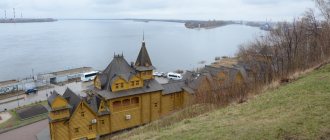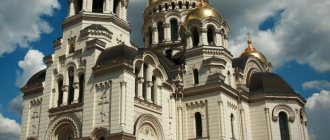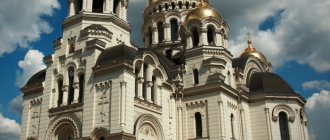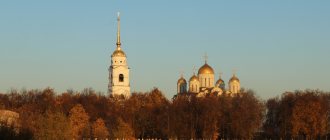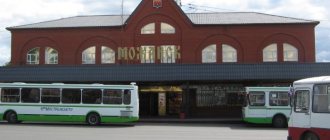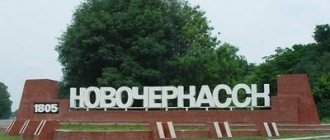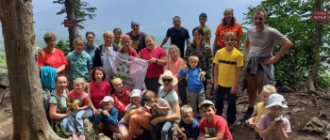Novocherkassk.net – Photos of Novocherkassk –
The capital of the Don Cossacks is Novocherkassk . There is so much implied in this phrase, even despite the relatively short history of the city. How many events have happened over the past two and a half centuries, how much has changed in the “appearance” of the city and in people’s lives. New buildings, factories and educational institutions were built, architectural monuments were restored. But, despite all this, in the appearance of the city it is impossible not to see its former “becoming” and greatness as a capital.
We love and respect our city for its history, beauty, and originality. For streets and avenues, courtyards and squares, mansions and small houses, museums and parks.
On this site we have collected photographs of Novocherkassk so that everyone can share their pride with us or remember the years they lived in our city. Probably even someone who has been to this city at least once will find a photo of Novocherkassk that will stir up a flow of nostalgia in him. Because no matter how long you stay here, these memories will always remain with you.
All photos can be viewed on the map of Novocherkassk.
latest comments
Sarry
To the photo “Lengnika Street, 21”: The error has been corrected, the photo was signed as Lengnika, 23. In the photo - Lengnika, 21. Number 23 is to the right
Sarry
To the photo “View of Yubileinaya Square, Baklanovsky Avenue, Ermak Stadium and the Novocherkassk Hotel”: evil virtual, the shooting date in all “digital” photos is indicated and written in the “photo information” block, down to the seconds 
evil virt
To the photo “View of Yubileinaya Square, Baklanovsky Avenue, Ermak Stadium and the Novocherkassk Hotel”: There is a date in the information on the photo, but you have to look into it specifically. Just add the date to the signature.
evil virt
To the photo “View of Yubileinaya Square, Baklanovsky Avenue, Ermak Stadium and the Novocherkassk Hotel”: The photo is good. I suggest indicating the date of the shooting so that you can later understand when it was so snowy and frosty.
Sashko
To the photo “Platovsky Avenue. Department Store: Vladimir Stepanov, who are these people? One is very similar to my relative, but he is no longer alive...
Lina43
To the photo “Engels Street, 6”: Be careful! I wouldn’t recommend buying apartments in this building on Engelsa 6: an old, senile brawler lives there, who is always quarreling with her neighbors in the house, with the neighboring houses and kicking mothers and children out of the playground! Stay away from this house, otherwise he will jump out and just start yelling!
Lina43
To the photo “Construction of a house on Engelsa 6”: Be careful! I wouldn’t recommend buying apartments in this building on Engelsa 6: an old, senile brawler lives there, who is always quarreling with her neighbors in the house, with the neighboring houses and kicking mothers and children out of the playground!
Lina43
To the photo “Engels Street, 6”: Be careful! I wouldn’t recommend buying apartments in this building on Engelsa 6: an old, senile brawler lives there, who is always quarreling with her neighbors in the house, with the neighboring houses and kicking mothers and children out of the playground!
donald
To the photo “Intersection of Platovsky and st. Moscow. New Year 1971-1972.”: The semi-rotunda is visible in the distance. So there's still some. When were they removed?
Whatever
To the photo “Construction of the NPI laboratory building”: I just can’t find a photo of this building from the 90s. If my memory serves me correctly, there was a mosaic with scientists on the wall on the right. Does anyone still have these photos? I really want to find
Last 50 comments
Novocherkassk Ascension Cathedral
History On the map Photos
Novocherkassk Ascension Cathedral is considered one of the most majestic in Russia, the third largest church building, second only to the Cathedral of Christ the Savior in Moscow and St. Isaac's Cathedral in St. Petersburg. Novocherkassk Cathedral is not only an Orthodox church, but also a historical monument of the Don Cossacks. His story is complex, but at the same time very interesting. More details
Alexander Nevsky Church
It is located right behind the Alexander Garden. It was founded in 1851 according to the decree of Nicholas I, in memory of the appointment of his son, Alexander, as the august chieftain. The church was built in 1896 in the Russian-Byzantine style, the stone bell tower was added in 1902. The church was called the ataman church, since it was often visited by military atamans who lived next to the temple.
Location: Alexandrovskaya street - 78.
Alexander Nevsky Church
On the map Photos
The church, designed by the architect Lavopierre, was built wooden, and therefore temporary, so its construction took little time. On June 29, 1810, Archpriest Alexey Oridovsky consecrated the newly built church. There was only one throne in the Alexander Nevsky Church, in honor of the holy noble prince Alexander Nevsky. In 1822, one of the residents of Novocherkassk, “who loves the splendor of the house of the Lord,” added a chapel to the church in the name of St. Great Martyr Paraskeva Pyatnitsa, consecrated on October 26 of the same year by Archpriest Jacob Merkhalev. December 22, 1896 The last liturgy was celebrated in the old wooden Alexander Nevsky Church, during which priest Vasily Petrov made a heartfelt speech about love for his temple, which for 86 years was the center of the spiritual life of many people. In 1898, the low, gloomy, cold and dark old church was dismantled and transported to the Mishkin village of the Novocherkassk village, where a new church was built from this material, consecrated on November 12, 1900. The new Alexander Nevsky Church, built behind the Alexander Garden (now the city park), was built, like the Ascension Cathedral, in the New Byzantine style, one-story, with a semicircle in the altar, behind which there is a room for the sacristy. The temple can accommodate up to 1,500 people for one service. The main dome inside is decorated with a picturesque image of the God of Hosts, and the semi-domes and walls of the temple are decorated with images of events from sacred history and the faces of saints, as well as sacred sayings. An iron staircase leads to the bell tower. The outside of the church was whitewashed, and plaster was placed only around the windows and doors. The inside of the temple was completely plastered, painted with oil paint and decorated with paintings.
Monuments to M.I. Platov
In Novocherkassk there are two monuments dedicated to M.I. Platov. One is installed opposite the main entrance to the cathedral on Platov Avenue. The bronze monument, where the ataman is on horseback, was opened on the 250th anniversary of his birth, in 2003.
The second monument, where M.I. Platov is represented standing on a pedestal, which is the first sculptural monument in the city. Opened in 1853, during Soviet times it was dismantled and melted down. The reconstruction of the monument in the same place took place in 1993. The monument is located in front of the Ataman Palace.
Location: Platovsky Avenue.
Museum of the History of the Don Cossacks
History On the map Photos
The Museum of the History of the Don Cossacks has a unique scientific library, which contains publications from the times of Peter the Great to the present day. There are many authentic things, manuscripts and books of scientists, literature and artists of the Don. Along with collections of archaeological objects, combat bladed weapons and firearms, coins and paper money, banners and standards, military uniforms and civilian clothing, including “Nekrasovites” who returned after many decades from Turkey to the Don, household items and furnishings mansions, the museum has large art collections of the St. Michael the Archangel Church funds not only of Don artists N.N. Dubovsky, I.I. Krylova, M.B. Grekova and others, but also paintings of Western European painting, collections of domestic and foreign crystal and porcelain (for example, Saxon, English, etc.). More details
South Russian State Polytechnic University
On the map Photos
Novocherkassk Polytechnic Institute is the largest university in the South of Russia. The complex of buildings of the institute, built according to the design of the architect Roguisky, is an architectural monument and amazes with its majesty and beauty. The resolution of the Council of Ministers of Russia, adopted in January 1907, provided for “the establishment of a polytechnic institute in Novocherkassk, using funds and personnel of the Warsaw Polytechnic for this purpose.” Student riots of 1905-1906 led to the temporary closure of the Warsaw (Russian) Polytechnic Institute by the authorities of the Russian Empire, and its leading employees were sent to Novocherkassk and formed the core of the teaching staff of the new institute. The institute was opened on October 5, 1907. At that time, the institute did not yet have its own buildings and was located in seven buildings in the city, remote from each other. Construction of the buildings began on October 9, 1911. The project included four buildings and was completed in 1930.
More details
Museum of M. B. Grekov
History On the map Photos
At the request of the public of Novocherkassk and the Rostov region, the Council of Ministers of the RSFSR established the M.B. House-Museum in the city. Grekov as a branch of the Museum of the History of the Don Cossacks. In the year of the 75th anniversary of the artist’s birth, June 30, 1957 at 16:00 on Grekova Street (until 1938 it was called Peschanaya Street) the grand opening of the House-Museum of the battle painter Mitrofan Borisovich Grekov took place. The House-Museum complex included: the residential building of M.B. Grekova of 6 rooms with a veranda, an outbuilding and a courtyard going down to the Tuzlov River. The following year, 1958, to the House-Museum of M.B. Grekov received a huge gift of 400 sketches by Mitrofan Borisovich, transferred from Moscow by the artist’s widow Antonina Leonidovna. In 1959 A.L. Grekova donated her husband’s personal belongings, sketches and other sketches to the museum. They made their contribution to the development of the M.B. House-Museum. Grekova are his friends and comrades. More details
Michael the Archangel Church
Novocherkassk has always been and is a stronghold of the Russian Orthodox faith. This is evidenced by a large number of temples and churches. Michael the Archangel Church, built in 1870, is located on Azov Square, not far from the western triumphal arch. Made in Russian style with onion domes.
Location: Platovsky Avenue - 79a.
Ataman Palace
On the map Photos
A two-story building in the classicist style. The Ataman Palace served as the residence of the military ataman, as well as the residence of the royal family who visited the city. These were Alexander II, Alexander III and Nicholas II. Design and construction were carried out by Academician I.O. Valprede in 1863. The rich decoration of the interior makes an indelible impression: state rooms with high vaulted ceilings, stucco moldings and paintings, huge marble fireplaces and carved furniture. Everything here points to the former presence of royalty. The courtyard adjacent to the back of the building in those days was decorated with flower beds and ornate paths, as well as a carved gazebo installed on a raised platform.
Triumphal arches
History Photos Northern Arch on the map Western Arch on the map
The triumphal gates at the northeastern and southwestern entrances to Novocherkassk preserve the memory of the heroic participation of the Don Cossacks in the Patriotic War and foreign campaigns of 1812-1814. More details
Don Drama and Comedy Theater named after. V. F. Komissarzhevskaya
History On the map Photos
The history of the Novocherkassk Theater begins in 1825, and in reality since 1859. The first date is connected with the fact that “since 1825, a small theater was opened in Novocherkassk, where a troupe of actors who come here from Taganrog at different times performs.” But the modern theater was built only in 1866, according to the design of the architect A. A. Campioni. Vera Fedorovna Komissarzhevskaya, after whom the theater is named, worked in Novocherkassk for only 167 days, playing 58 roles during this time. But even this short period of her development as an actress remained forever in the memory of Novocherkassk theatergoers. Vera Feodorovna’s entire stage life turned out to be short-lived. She died of smallpox in 1910 while on tour in Baku. More details
What to see in Novocherkassk in one day
Tourists need a lot of time to get to know all the sights of Novocherkassk in detail. But if you are in this city for just one day, then for a walking tour you need to use approximately the following route:
- Start your tour from Ermak Square in the center of Novocherkassk. Here you will see the main Cossack temple - Ascension Cathedral .
- Opposite the cathedral on Platovsky Avenue you can see a monument to the founder of the city N.I. Platov .
- The next point of your journey around the city is the Don Cossacks Museum located on Atamanskaya Street.
- After getting acquainted with the exhibits, go to the next attraction - Ataman Palace , which is located just a 15-minute walk from the museum, on Dvortsovaya Street.
- the Alexander Garden located next to it , go to the city's triumphal arch on Platovsky Prospekt.
- The best option to end the excursion would be a walk in Tolokonnikova Park , where you can relax and enjoy exotic plants.
Important! Most of the proposed route runs along Platovsky Prospekt. On this street, in addition to the places mentioned, you can see many other attractions.
